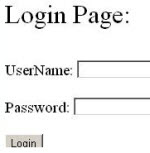There are many aspects while designing a login page for a website that uses cloud computing.
What are the various aspects to keep in mind while designing a login page for a website?
The various aspects to consider are:
- Design
- Universal Login
- Revenue considerations
- User Input Validation
Today, majority of login pages fall in two major categories:
1. Conventional Login pages
2. Custom Login pages
Conventional Login pages
As the name suggests conventional login pages is the standard on the internet.
Websites that fall in this category include Google /Gmail, Yahoo and Microsoft.
e.g.
Gmail Login Page
The login box is shown to the extreme right of the login page. This is the standard way as used widely on the internet.
The obvious benefit is that a user does not have to search for a login box. However, this approach needs a separate page for login. This type of login page design arose during the nineties and was pioneered by dot com companies like Yahoo.
Also an advertisement can be shown on the left hand side of the page. Big websites like Yahoo and Microsoft use the left hand side of a login page to tell users about various services.
2. Custom Login pages
The custom login page category is further divided into two categories:
1. The login box is located on the homepage of the website
2. The login box pops up in a small window
The site that uses the first category is Facebook. The Facebook Login Box is located at the top most right corner of the webpage.
Twitter and Facebook use both the categories widely. They use when the user has entered a wrong password or username.
Grooveshark uses the secondary category.

Now comes the technical part of user validation. Most websites use JavaScript for validating user input on the client side. But all websites have server-side validation to stop hacker attacks like Sql Injection etc.
In GMail, if the user enters the wrong username or password, he / she is redirected to the login page. However now the login page contains the previously entered username. This is not true for Twitter and Yahoo as both username and password are shown as empty.
Every time I open the Facebook homepage, I see that the username is already populated. I guess that FB is using some cookies to store the user email information.
Nowadays popular Universal login options like OpenID and Facebook Connect are used widely. They allow a user to use more than one websites with a registered login information of any website.
The obvious benefit is that a user does not have to search for a login box. However, this approach needs a separate page for login. This type of login page design arose during the nineties and was pioneered by dot com companies like Yahoo.
Also an advertisement can be shown on the left hand side of the page. Big websites like Yahoo and Microsoft use the left hand side of a login page to tell users about various services.
2. Custom Login pages
The custom login page category is further divided into two categories:
1. The login box is located on the homepage of the website
2. The login box pops up in a small window
The site that uses the first category is Facebook. The Facebook Login Box is located at the top most right corner of the webpage.
Twitter and Facebook use both the categories widely. They use when the user has entered a wrong password or username.
Grooveshark uses the secondary category.

Now comes the technical part of user validation. Most websites use JavaScript for validating user input on the client side. But all websites have server-side validation to stop hacker attacks like Sql Injection etc.
In GMail, if the user enters the wrong username or password, he / she is redirected to the login page. However now the login page contains the previously entered username. This is not true for Twitter and Yahoo as both username and password are shown as empty.
Every time I open the Facebook homepage, I see that the username is already populated. I guess that FB is using some cookies to store the user email information.
Nowadays popular Universal login options like OpenID and Facebook Connect are used widely. They allow a user to use more than one websites with a registered login information of any website.






1 comments:
I just required commenting & say maintain the quality work. I’ve bookmarked your blog just now and Ill be back to read more in the future my friend!
Post a Comment
What do you think?.